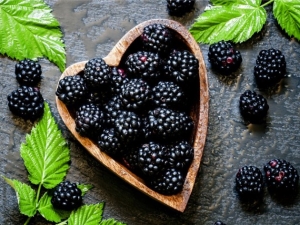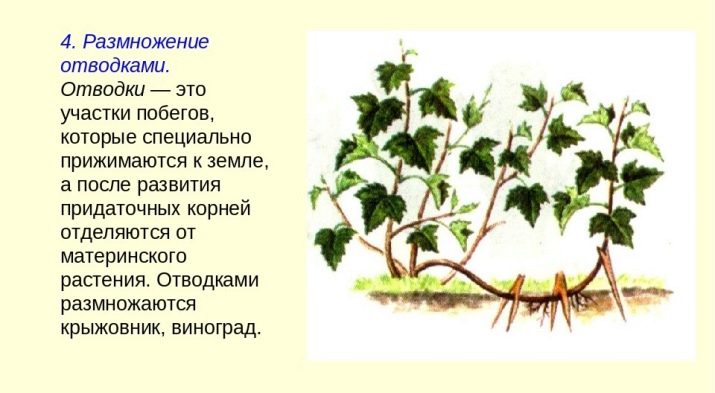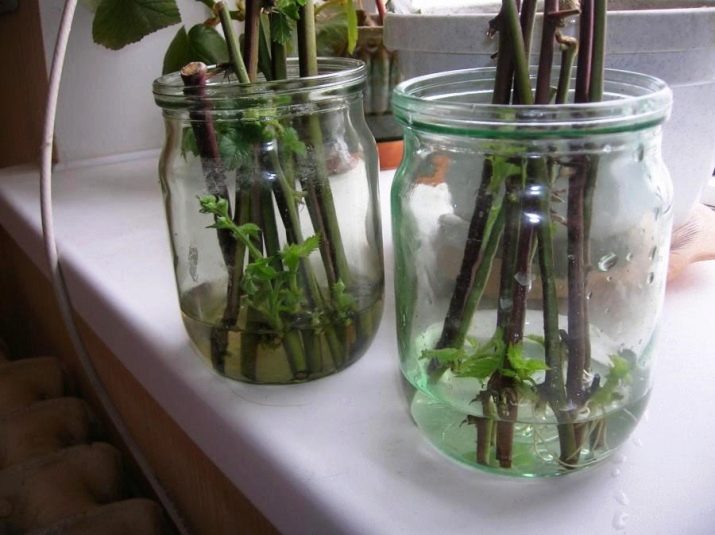Rules and methods of breeding blackberry

When it comes to blackberries, then immediately recall the summer forest and pleasant aroma of this forest berries. But it turns out, it is not necessary to go to the forest for blackberries.It can be successfully grown in the country.
Timing
Breeding blackberries - delicious, fragrant and healthy berries - has become very popular in recent years. There are a lot of arguments in favor of its cultivation: useful berries, it is undemanding in its care and, in addition, it can be used as a living and very beautiful hedge.
The peculiarity of the blackberry is that it can grow for a long time (up to 10 years) at the same place and bring a big harvest. Another feature is that it is quite simple to propagate a blackberry and it can be seated not only in spring and autumn, like other cultures, but also in summer.
Autumn is the best time for breeding. During this period, the blackberry is at rest, and with the onset of cold weather, plant stratification occurs in natural conditions. Saplings adapt to cold and gain stamina.
The timing of the autumn landing is directly dependent on the climate of the region. But you need to comply with this condition - it must be planted no later than a month before the onset of the first frost.
In the spring it is effective to plant seedlings or cuttings that have roots. Spring planting ensures the rapid growth of blackberry, the development of a powerful root system and good survival. Planting in the spring also allows you to control the growth of blackberries and determine its viability.
A negative factor is that with the onset of heat, the moisture content of the soil quickly disappears, which requires monitoring the condition of the soil under the bush and regular watering.
The timing of spring planting also depends on the climatic and weather conditions of each area. Landing is possible only after the onset of heat (at a stable +15 degrees) and there is no threat of frost return. The earth should warm up well by 10–15 cm.
Typically, this time comes to mid-spring, and the landing period lasts from the second decade of March to the first of May, depending on the region.
If the spring is long and in March it is still cold, then the landing is postponed to a later date. But it is necessary to have time to plant a blackberry before the leaves start to bloom on the saplings.
In the summer you can also reproduce blackberries. Most often, during this period, reproduction is applied using cuttings, by dropping the shoots, as well as transplanting young shoots and dividing the blackberry bush into daughter shoots.
Breeding methods
There are many ways to breed blackberries, and they depend on the season of their implementation.
Cuttings
The cuttings can be carried out both root and stem cuttings. Effective method is the cultivation of blackberry root cuttings. It is held in November.
- Blackberry bush need to dig, carefully release the roots and cut cuttings from them, and then bury the roots again.
- For cuttings suitable for roots with a thickness of 0.3 to 1.5 mm. The length of the cutting should be 6–9 cm.
- Fold the cuttings in any bag and store in a cold place (cellar, refrigerator) at a temperature not exceeding +5 degrees.
- Regularly once a week, it is necessary to check the condition of the cuttings and air them.
- In the last days of February, the cuttings should be placed in a container, covered with a layer of earth of 3 cm and placed for germination on a window sill or other warm and bright place.
- Soon, the cuttings will sprout, and in April, grown seedlings can be planted in the ground.
If there is a need for a large number of seedlings, then resorted to cuttings from the stems. It is carried out in October, and it is done in a certain sequence.
- For the cuttings choose the shoots of this season, and only those that managed to stiffen.
- Their length should be about 40 cm.
- Cuttings need to be buried in the soil at 30-40 cm. They spend the winter in the soil.
- In the spring, in April, they dig out the cuttings and re-prune their ends.
- After that, you need to expand the cuttings on the ground with an interval of 10-15 cm, and then bury them in the soil.
- To speed up their germination, it is recommended to make a small greenhouse of arcs and polyethylene.
- Periodically it is necessary to produce watering cuttings and remove weeds.
- You can dig up cuttings after new blackberry shoots form on them and real leaves appear on the shoots (2-3 pieces).
- The cuttings are divided into seedlings with young shoots and transplanted into any container in order to root them well.
- Young bushes can be planted in the ground when new stems and young leaves grow.
Layering
The method of propagation by layering is best suited for climbing blackberries. This method allows her to breed in the summer and grow many new bushes at once. It is carried out in early August and carried out in this way.
- One-year young escape tilted to the ground, not separating it from the mother bush.
- Dig a ditch (about 20–30 cm deep) in which you carefully place the shoot and cover it with earth.
- The top and shoots on the shoot must remain on the ground, but they must be cut to about 10 cm to stop growth.
- The soil needs to be compacted, sprinkled with a heavy object to prevent it from straightening.
- Then the landing site should be mulched and regularly maintain soil moisture.
- Approximately in 1-2 months young saplings will take roots, the cuttings can be dug out. It is better to do this with a fork, so as not to damage the young roots.
- Each young sapling is cut and planted in a separate place.
You can dig up the shoot in the fall (late September or early October), and the rooted seedlings are transplanted in the spring of next year.
Layers can be done and the tops. The apical method is the best option for breeding varieties of creeping and curly blackberries. It is possible to carry out a cutting only in the last days of August or the first days of September. Before the onset of frost, the process will have time to sprout, take root and settle down.
In order to properly implement this method, use annual blackberry shoots with a length of one and a half meters.
- The apical part of the shoot is buried in the soil to a depth of 10–15 cm.
- Approximately in a month young shoots appear at the tops and the root system is actively developing.
- Spikes must be covered for the winter foliage or covering material.
- After overwintering in spring, young saplings dig and plant in another place.
Seeds
Blackberries are also propagated by seeds. Blackberry seeds are easy to get, but the germination process itself is inactive. For seeds, you need to choose only perfectly ripe berries. First they are dried and only then seeds are selected. There is a lot of seeds in one berry.
The order of action is as follows.
- Soak the seeds and keep them in water for 2–3 days. It is recommended to use thawed or rainwater, as soaking in tap boiled water does not give good results.
- Then the seeds are placed in a mixture of white sand and peat in a ratio of 1: 3 and put in a cool place (for example, in a refrigerator) for 1.5-2 months. This stratification procedure is necessary for hardening the seeds.
- After the seeds are sown in the container with the soil, placing them with a distance of 3-4 cm. The depth of planting should not exceed 8 mm.
- The optimum temperature for seed germination is +20 degrees.
- Seedlings need to be watered as necessary with distilled boiled water.
- Germinated sprouts can be transplanted into the ground when there are 3–4 true leaves on them.
It should be noted that with this method of reproduction in young seedlings maternal properties are not preserved.
Dividing bush
There are some varieties of garden blackberries, which do not grow young shoots. Therefore, the division of the bush is the only way to propagate the blackberry.
This method is carried out in the fall (September or October) before cutting the plant. The division is also done in a certain sequence.
- A few days (2-3) before dividing it is necessary to water blackberry bushes well.
- Around the bush to dig a groove, departing 30-40 cm from the radical neck.The roots that are on the other side of the groove, you need to chop off with a shovel.
- Dig a bush around the perimeter and carefully dig it out, trying not to damage the roots.
- Shaking the bush, free the roots from the soil.
- Divide the roots into pieces and cut them with a sharp garden knife. Each part of the bush should be young shoots (1-2) with roots.
- Remove old or damaged stems, cut rotten roots, shorten shoots, leaving 30 cm. On each of the remaining branches there should be at least 2-3 processes and at least one underground bud on the roots.
- These seedlings are transplanted on harvested pits located at a distance of up to 3 m from each other in a row. The row spacing should be approximately 2 m.
In the spring to breed blackberries can be offspring. Planting seedlings can only be taken from blackberry bushes that grow and bear fruit for more than three years. Such a blackberry has a powerful, strong and overgrown root system, from which young shoots sprout from - sprouts.
It is advisable to plant the offsprings early (until mid-summer) so that the young growth does not take away food from the mother bush.
They are carefully dug out of the soil along with a small section of the root system, chopping off the main root and, without shaking off a clod of soil, are planted in the chosen place.
Reproduce blackberries can also be a sleeping kidney. This method is quite long, but effective.
- In the middle of autumn (October), cut annual shoots for cuttings so that each has 2-3 buds. They should be placed in a cold place and stored until spring.
- In late February or early March, the cuttings should be placed in a container with water so that the upper kidney is in liquid.
- The container should be kept in a warm bright place and water should be added regularly.
- After the sprout and roots emerge from the kidney, this part of the cutting is cut off and transplanted into a container with earth for further growth.
- In the same way, the subsequent buds are placed on the handle, germinated and transplanted. Then the grown seedlings are transplanted into the ground.
The best method of reproduction of reparative blackberry is reproduction by the root bud. It is also possible to use the methods of rooting the tops and horizontal slips.
Upright growing blackberry - blackberry tree - propagated mainly by root suckers or cuttings from the roots.
Aftercare
To grow a blackberry and get a big crop, you need to provide it with appropriate care. He is in compliance with all the rules of agricultural engineering: watering, loosening, weeding, fertilization, timely pruning.
To facilitate harvesting, climbing and creeping varieties of blackberry is recommended to install trellis, which tied the bushes.
Blackberries require watering throughout the growing season. It is carried out regularly as needed. Especially needed watering during the ovary of the fruit and shoot growth. For irrigation, it is recommended to use rainwater or water that has settled for 1-2 days. Blackberries stop watering only in October.
Blackberry is also needed in top dressing. At the beginning of the growing season, nitrogen fertilizers (urea, ammonium nitrate) are applied in an amount of 20 g per square meter. m. and organic - about 4 kg per square. m. Every year you need to feed blackberries and potash fertilizers that do not contain chlorine. If organic has not been used, then phosphate fertilizers must be applied.
As needed, weeds are removed and soil is loosened to a depth of 10–12 cm between the rows. Under the blackberry bushes, loosening the soil is done with forks about three times during the season. Loosening depth is about 8 cm.
Effectively carry out mulching with straw, leaves or sawdust. This will allow less often to loosen and weed. If manure or peat is used as mulch, it will also become an additional source of nutrition for plants.
Straight-growing blackberry varieties require regular pruning and shortening of young shoots that are about 1 m long.These shoots are cut tops by 10 cm, and grown lateral shoots begin to shorten when they reach a height of 50 cm.
Blackberries suffer from the same diseases as other berry bushes. The most common diseases are powdery mildew, rust, white and purple blotch, gray mold. Preventive work will protect against infection. They consist in spraying blackberries with a 1% solution of Bordeaux mixture in the spring after blooming leaves. And in the fall after picking the berries do the repeated spraying.
In addition, you need to carry out prevention and against harmful insects that infect blackberries: ticks, weevil, raspberry moth, and nut crabs. The treatment in the spring after the blooming of the leaves, and in the fall after the harvest with the means of Karbofos, Fitoverm, Aktellik, will protect the bush from being affected by these pests.
On the useful properties of blackberry you will learn from the following video.



































